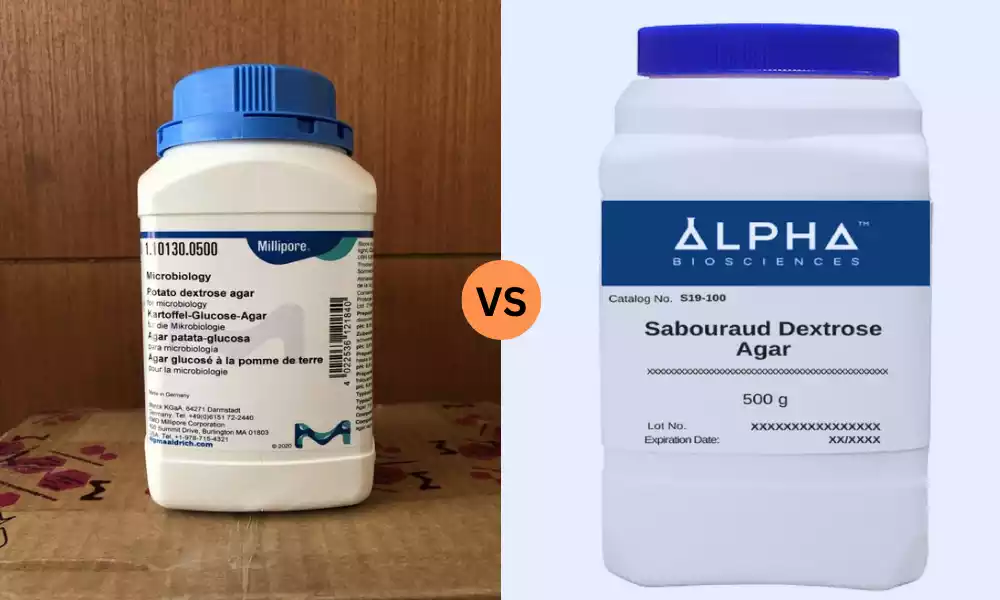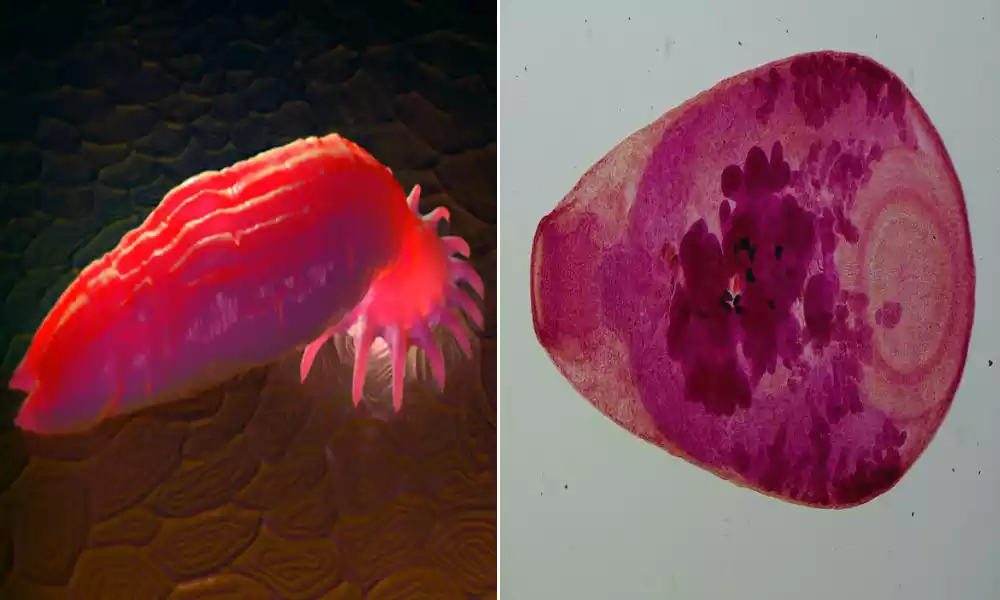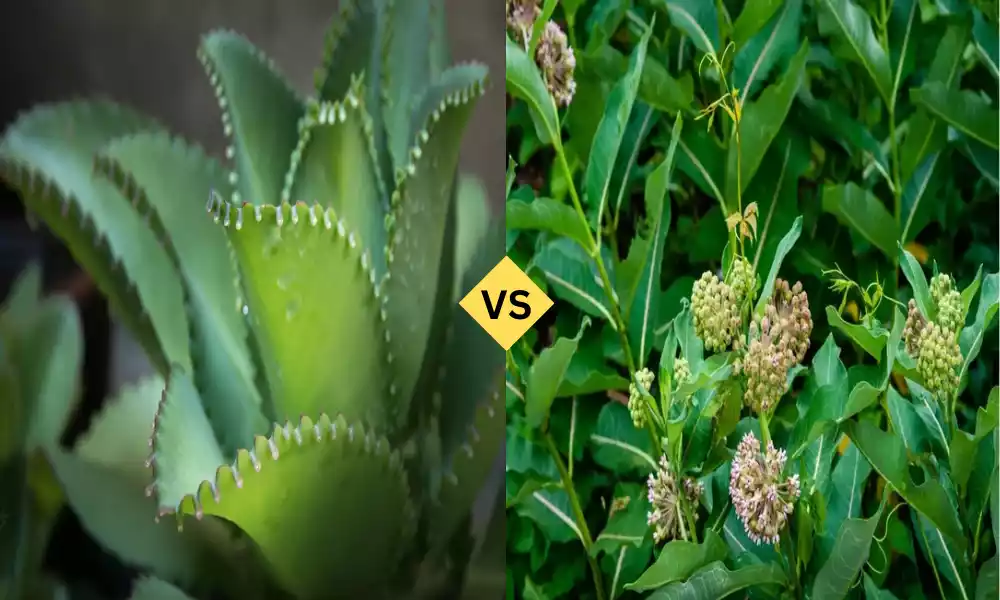Potato Dextrose Agar and Sabouraud Dextrose Agar are both common culture media used for cultivating fungi. PDA is formulated from potato infusion and dextrose and is particularly effective for promoting the growth of molds and yeasts. SDA, developed by Raymond Sabouraud, contains dextrose and peptones, making it ideal for the isolation, cultivation, and differentiation of dermatophytes, yeasts, and other fungi. Both media provide an acidic environment that inhibits bacterial growth, ensuring the selective proliferation of fungal organisms.
What is Potato Dextrose Agar?
Potato Dextrose Agar (PDA) is a common nutritive medium used predominantly for the cultivation of fungi. The composition mainly includes dextrose, which provides carbohydrates for growth, and potato infusion, which acts as a nutrient source. The agar serves as a solidifying agent. PDA is a rich medium which allows many fungi, including molds and yeasts, to grow luxuriantly.

History of Potato Dextrose Agar
PDA has its origins in early fungal cultivation techniques. Originally, mycologists used slices of potato to grow mold. However, with advancements in understanding and technology, potato infusion became a basis to which dextrose was added to enhance growth. The incorporation of agar made the medium solid, providing a stable platform for mycelial growth and spore production.
Uses of Potato Dextrose Agar
- Cultivation of Fungi: PDA is widely used for cultivating molds and yeasts.
- Determination of Morphological Features: Due to its nutritive properties, fungi grow well, showing typical morphological features.
- Preservation of Fungal Cultures: It serves as a maintenance medium for fungal stocks.
- Production of Spores: PDA induces sporulation in many fungal species.
What is Sabouraud Dextrose Agar?
Sabouraud Dextrose Agar (SDA) is another medium primarily designed for the growth of fungi, especially dermatophytes, yeasts, and molds. The basic components include dextrose, as a source of carbohydrate, and peptone, providing amino acids. Its acidic pH (around 5.6) suppresses bacterial growth, offering a selective environment for fungi.
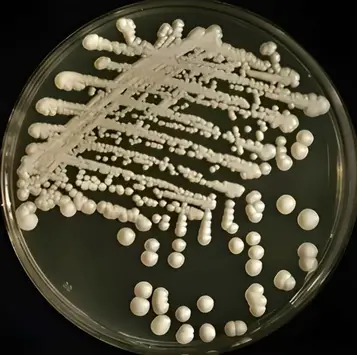
History of Sabouraud Dextrose Agar
Named after its developer, Raymond Sabouraud, a French dermatologist, SDA was formulated in the early 20th century. Sabouraud designed this medium to isolate dermatophytes from clinical specimens, and it quickly became the standard for mycological studies.
Uses of Sabouraud Dextrose Agar
- Isolation of Dermatophytes: It’s an ideal medium for isolating skin fungi.
- Growth of Yeasts: Candida species, among others, can be readily cultivated.
- Routine Mycology: SDA is standard in many labs for primary fungal cultures.
- Selective Cultivation: Its low pH discourages bacterial growth, making it selective for fungi.
Comparison Table of Potato Dextrose Agar and Sabouraud Dextrose Agar
Comparison Table of Potato Dextrose Agar and Sabouraud Dextrose Agar
| Feature | Potato Dextrose Agar (PDA) | Sabouraud Dextrose Agar (SDA) |
|---|---|---|
| Primary Use | Fungal Growth | Dermatophyte & Yeast Growth |
| Key Components | Potato infusion, Dextrose | Dextrose, Peptone |
| pH | Neutral | Acidic (around 5.6) |
| Bacterial Growth Suppression | No | Yes (due to acidic pH) |
| Origin | Early fungal cultivation | Developed by R. Sabouraud |
| Selectivity | Non-selective | Selective for fungi |
| Common Organisms Cultured | Various molds and yeasts | Dermatophytes, Candida species |
This table provides a concise snapshot of the primary distinctions between PDA and SDA. Each agar serves specific purposes in the microbiology lab based on its characteristics and utility.
Similarities of Potato Dextrose Agar and Sabouraud Dextrose Agar
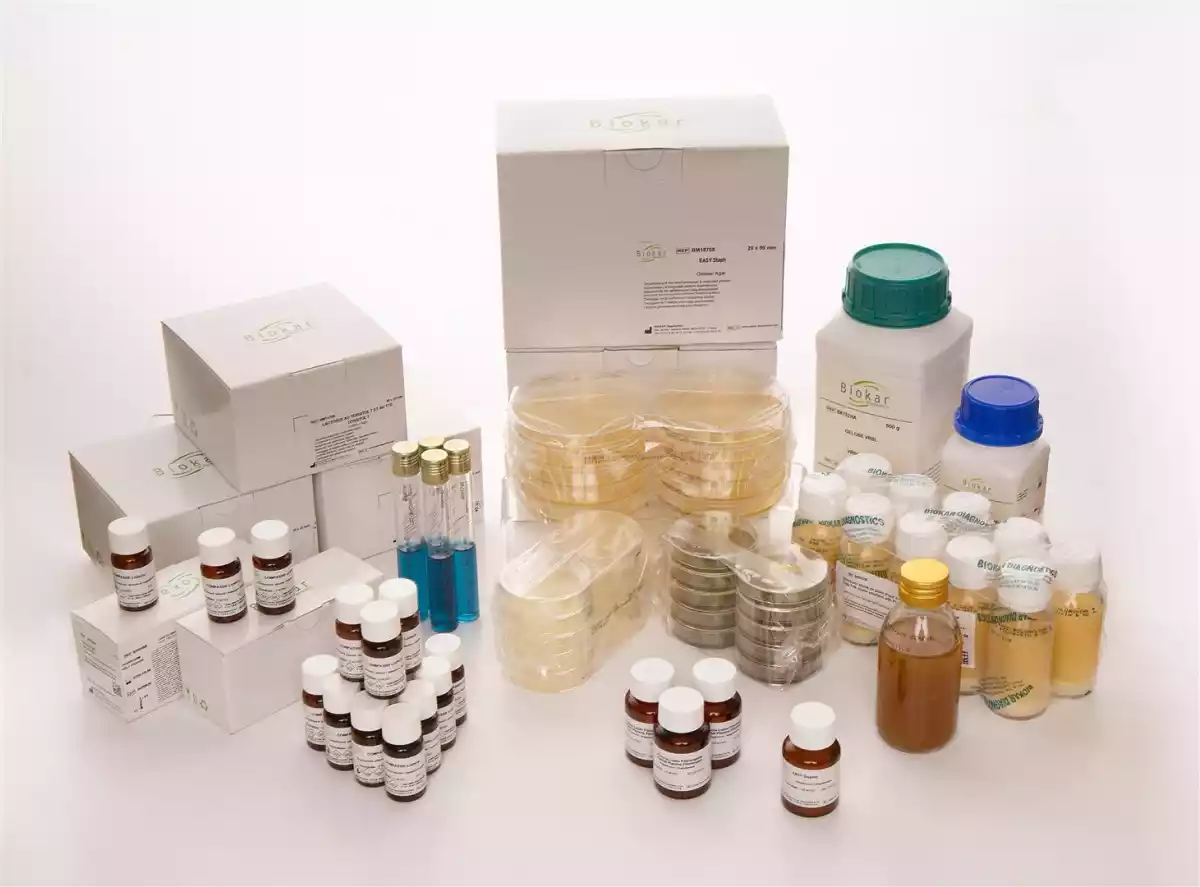
Similarities Between Potato Dextrose Agar (PDA) and Sabouraud Dextrose Agar (SDA):
- Purpose: Both PDA and SDA are primarily used for the cultivation of fungi, including molds and yeasts.
- Dextrose: Both media contain dextrose as a primary source of carbohydrate, which serves as an essential energy source for fungal growth.
- Solidifying Agent: Agar is used in both media as a solidifying agent, providing a firm surface for fungal colonies to grow.
- Mycology Applications: Both are fundamental tools in mycology labs for isolation, cultivation, and identification of various fungal species.
- Usage in Clinical Microbiology: Both PDA and SDA are frequently utilized in clinical microbiology settings for diagnosing fungal infections.
- Standardized Formulations: Both media are commercially available in standardized formulations, ensuring consistency and reproducibility in fungal growth conditions.
- Appearance: When not inoculated, both PDA and SDA plates appear clear to slightly opaque, allowing for easy observation of fungal colonies.
- Stability: Both media offer long shelf-lives when stored appropriately, making them reliable choices for routine use.
- Adaptability: Both PDA and SDA can be modified or supplemented with additional ingredients, like antibiotics or other substances, to enhance selectivity or cater to specific research needs.
- Role in Research: Both media serve as platforms for a variety of research applications, including studying fungal physiology, genetics, and biochemistry.
These similarities underscore the integral role both PDA and SDA play in mycology and clinical microbiology. Despite their differences, their shared characteristics make them invaluable tools in the study and diagnosis of fungi.
Importance in Microbiology
Microbiology, as a field, constantly strives to understand and categorize the vast diversity of microorganisms. This requires tools and techniques tailored to specific groups of microorganisms. PDA and SDA, being primary media for fungal growth, hold significant importance in the discipline. Here’s why:
- Tool for Fungal Studies: Both PDA and SDA are indispensable for mycologists. Fungi, being eukaryotic organisms, have different growth requirements than bacteria. These media provide the right environment for most fungi to thrive.
- Clinical Diagnostics: Fungal infections, particularly those affecting the skin, nails, and mucous membranes, have been on the rise. SDA, with its ability to support dermatophyte growth and suppress bacterial growth, becomes essential for clinical diagnosis. Similarly, PDA plays a role in isolating and identifying a variety of fungi from clinical specimens.
- Research Platform: Understanding fungal genetics, metabolism, and pathogenicity requires consistent growth platforms. Both PDA and SDA provide a foundation for researchers to conduct experiments, be it genetic manipulation or studying antifungal resistance.
- Environmental Microbiology: Fungi play crucial roles in various ecosystems, from decomposers to mycorrhizal partners. PDA and SDA are used to isolate and study fungi from environmental samples, helping ecologists understand fungal diversity and function in nature.
- Pharmaceuticals and Biotechnology: Fungi are a treasure trove of metabolites, some of which have pharmaceutical importance. Media like PDA and SDA aid in cultivating fungi for bioprospecting – the search for novel compounds with potential pharmaceutical applications.
- Quality Control: In industries, especially food and pharmaceuticals, the presence of fungi can be detrimental. PDA and SDA are employed in quality control labs to check for fungal contaminants.
- Selectivity and Flexibility: While both media support fungal growth, SDA’s slightly acidic pH offers selectivity by suppressing most bacterial growth. This flexibility allows microbiologists to choose the best medium based on their needs.
- Cultural Characteristics: The growth of fungi on these media often presents with characteristic morphologies. This assists in preliminary identification based on colony color, texture, and other features.
- Education and Training: For students and trainees in microbiology, PDA and SDA serve as fundamental tools for learning fungal isolation, identification, and basic mycological techniques.
- Global Health: With the rise of immunocompromised populations due to conditions like HIV/AIDS, organ transplants, and chemotherapy, opportunistic fungal infections have become more prevalent. Media like SDA and PDA aid in monitoring, diagnosing, and researching these pathogens.
The importance of PDA and SDA in microbiology cannot be overstated. They serve as critical tools that span various applications from basic research to clinical diagnostics, ensuring that the study and understanding of fungi continue to progress.
Benefits in Research
In the realm of scientific research, growth media like PDA and SDA offer numerous advantages. The specific benefits they bring to fungal and microbiological research are manifold:
- Consistent Growth Platform: Both PDA and SDA offer a standardized environment. This ensures that experiments conducted across different times or even different labs can have consistent growth conditions, a cornerstone for reproducible results.
- Diverse Fungal Cultivation: Given their composition, these media support the growth of a wide variety of fungi, from yeasts like Candida to molds like Aspergillus. This enables researchers to work with multiple fungal species.
- Morphological Studies: The growth of fungi on PDA and SDA often exhibits characteristic morphological features. This aids researchers in studying various aspects of fungal development, spore formation, and colony differentiation.
- Genetic Research: For genetic manipulation experiments, fungi need to be cultivated efficiently. PDA and SDA provide the necessary conditions for successful transformation, gene knockout, and other genetic studies.
- Antifungal Susceptibility Testing: With the rise of antifungal resistance, there’s a need to test fungal strains against various antifungal agents. PDA and SDA can be modified to serve this purpose, helping in the development of new antifungal treatments.
- Metabolite Production: Many fungi produce secondary metabolites with potential pharmaceutical applications. Cultivation on PDA and SDA can lead to the production of these metabolites, aiding in drug discovery.
- Selective Studies: While PDA offers a more generalized growth platform, the slightly acidic nature of SDA makes it selective for fungi, reducing bacterial contamination. This selectivity can be advantageous in certain research settings.
- Economical: Both PDA and SDA are cost-effective, making them accessible to researchers globally, even in settings with limited funding.
- Modifiability: Researchers can easily augment PDA and SDA with additional compounds, such as antibiotics, to make them more selective or to study specific interactions.
- Biochemical and Physiological Studies: Both media can be used to study various fungal biochemical pathways and physiological responses, from stress responses to nutrient assimilation.
- Environmental Monitoring: For environmental microbiologists, these media provide tools to monitor and study fungi present in soil, water, or air samples, offering insights into fungal roles in ecosystems.
- Bioinformatics and Omics Research: With advancements in genomics, proteomics, and metabolomics, consistent cultivation of fungi becomes essential. PDA and SDA provide a stable foundation for researchers delving into the “omics” of fungi.
PDA and SDA, by virtue of their properties and adaptability, serve as invaluable tools in the research arena. They not only advance our understanding of fungi but also pave the way for innovations in medicine, agriculture, and environmental science.
Role in Diagnostics
Role of Potato Dextrose Agar (PDA) and Sabouraud Dextrose Agar (SDA) in Diagnostics (Summarized):
- Isolation: Both PDA and SDA are used for isolating pathogenic fungi from clinical samples.
- Selectivity: SDA’s acidic pH allows selective growth of fungi while suppressing many bacteria, making it ideal for samples with mixed microorganisms.
- Morphological Clues: The characteristic appearance of fungi on these media aids in preliminary identification.
- Dermatophyte Detection: SDA supports the growth of dermatophytes, the primary fungi causing skin, hair, and nail infections.
- Yeast Cultivation: Yeasts like Candida grow well on SDA, aiding in the diagnosis of yeast infections.
- Opportunistic Infections: Both media assist in detecting fungi that cause infections in immunosuppressed patients.
- Antifungal Testing: Modified versions of these media can be used to check a fungus’s sensitivity to antifungal drugs.
- Slide Cultures: They’re used for slide cultures to observe fungal structures microscopically.
- Rapid Diagnostic Indicator: The unique growth of some fungi on these media can speed up diagnosis.
- Environmental Checks: Both agars help in identifying fungi in environmental samples, assisting in tracking contamination sources.
- Quality Control: PDA and SDA serve as benchmarks in diagnostic labs to ensure test accuracy.
- Foundation for Advanced Diagnostics: Once fungi are isolated on these media, they can be subjected to sophisticated diagnostic tools for further analysis.
PDA and SDA are cornerstones in fungal diagnostics, facilitating accurate detection and identification of fungal pathogens.
Conclusion
While Potato Dextrose Agar and Sabouraud Dextrose Agar share common ground in the world of mycology, their individual characteristics set them apart. PDA’s rich and nourishing environment contrasts with SDA’s selective, slightly acidic milieu. Their importance in both research and diagnostics showcases their enduring relevance in microbiology, highlighting the vast and varied world of fungi.

